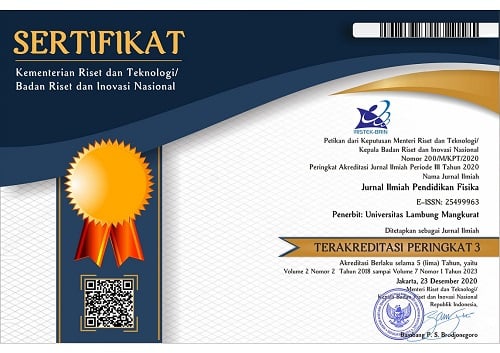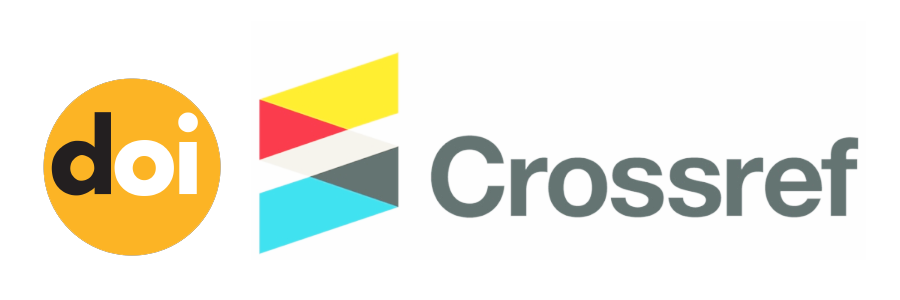The Effect of Using Context-Based Physics Learning Videos on Critical Thinking Skills of XI Grade High School Students
Abstract
Education in the 21st century demands the readiness of students to face the ever-evolving era. This study aims to determine the effect of using context-based physics learning videos on the critical thinking skills of class XI students at SMA N 1, Suliki District. Students' critical thinking skills at SMA N 1 Suliki District are still low because the use of instructional media has not honed students' critical thinking skills. One solution to this is through the use of context-based physics learning videos. This type of research is quasi-experimental. Posttest-Only Control Design research design. The population in this study were all students from class XI SMA N 1 Suliki District for the 2021/2022 academic year. The process of taking samples is carried out through a purposive sampling technique, namely choosing two classes with the same average. The data collected is from students' critical thinking skills, including "interpretation, analysis, evaluation, and inference". The data was obtained using a written test instrument in the form of essay questions with as many as 8 items. The data analysis technique used in the hypothesis test is the t test. Based on the results of data analysis, it was found that the average ability of students' critical thinking for the experimental class was higher than the control class. The results of the t hypothesis test obtained a calculated value with a magnitude of 2.729 and a critical value for the significance level at α = 0.05, and 67 degrees of freedom obtained a value of 2.293. Because the calculated value is greater than the critical value, the hypothesis is accepted at a significant level of 0.05. Based on the results obtained, it can be concluded that using context-based physics teaching videos has an effect on the critical thinking skills of class XI students at SMA N 1 Suliki District.
Keywords
Full Text:
PDFReferences
Andriani, K., Subiki, S., & Supriadi, B. (2021). Pengaruh model problem based learning (pbl) disertai video berbasis kontekstual terhadap hasil belajar dan keterampilan proses sains dalam pembelajaran fisika di sma. Jurnal Pembelajaran Fisika, 10(1), 36. https://doi.org/10.19184/jpf.v10i1.19687
Antoni, A. M., Hidayat, F., & Khatimah, H. (2021). Meta analysis of the effect of guided inquiri model on physics currents on students’ critical thinking ability. Jurnal Pendidikan Fisika, 10(2), 135. https://doi.org/10.24114/jpf.v10i2.29361
Dewantara, D., Mahtari, S., & Misbah, M. (2021). Create an interactive video about alternative energy sources from fruits to optimize student creativity. Journal of Physics: Conference Series, 1760(1), 012019. IOP Publishing.
Dole, S., Bloom, L., & Kowalske, K. (2016). Transforming pedagogy: Changing perspectives from teacher-centered to learner-centered. Interdisciplinary Journal of Problem-Based Learning, 10(1), 1.
Fatahullah, M. M. (2016). pengaruh media pembelajaran dan kemampuan berpikir kritis terhadap hasil belajar ips. Sejara, 7, 237–252.
Hafizah, S. (2020). Penggunaan dan pengembangan video dalam pembelajaran fisika. Jurnal Pendidikan Fisika, 8(2), 225. https://doi.org/10.24127/jpf.v8i2.2656
Hamida, D, S. (2020). Analisis kebutuhan video pembelajaran fisika berbasis kontekstual materi suhu dan kalor untuk pembelajaran abad 21. Jurnal Pendidikan Fisika, 9(1), 42–49.
Hartini, S., Misbah, M., Dewantara, D., Oktovian, R. A., & Aisyah, N. (2017). Developing learning media using online prezi into materials about optical equipments. Jurnal Pendidikan IPA Indonesia, 6(2), 313-317.
Hartini, S., Mariani, I., Misbah, M., & Sulaeman, N. F. (2020). Developing of students worksheets through STEM approach to train critical thinking skills. Journal of Physics: Conference Series, 1567(4), 042029. IOP Publishing.
Hasan, M. M. D. H. K. T. (2021). Media pembelajaran. Tahta Media Group (Issue Mei).
Hasanah, U., Lesmono, A. D., & Astutik, S. (2019). Penerapan model problem based learning disertai video tracker materi momentum dan impuls untuk membelajarkan kemampuan berpikir kritis siswa di sma. Saintifika. https://jurnal.unej.ac.id/index.php/STF/article/view/11125
Indayani, R., Supeno, S., & Wicaksono, I. (2021). Pengaruh videoscribe terhadap keterampilan berpikir kritis peserta didik pada pembelajaran IPA. Edu Sains: Jurnal Pendidikan Sains Dan Matematika, 9(2), 107-115.
Kamalia, N., & Wasis, W. (2021). Analisis keterampilan berpikir kritis peserta didik sma dalam menyelesaikan soal fluida statis. IPF: Inovasi Pendidikan Fisika, 10(1), 90–98.
https://doi.org/10.26740/ipf.v10n1.p90-98
Lestari, S. (2018). Peran teknologi dalam pendidikan di era globalisasi. Edureligia; Jurnal Pendidikan Agama Islam, 2(2), 94–100. https://doi.org/10.33650/edureligia.v2i2.459
Muhibbin, A., Monica, G. T., Patmisari, P., & Muthali’in, A. (2021). Implementasi media audio visual untuk meningkatkan critical thinking siswa menggunakan strategi point counterpoint. ASANKA: Journal of Social Science And Education, 2(2), 233–252.
https://doi.org/10.21154/asanka.v2i2.3181
Pangestu, R. D., Mayub, A., & Rohadi, N. (2019). Pengembangan desain media pembelajaran fisika sma berbasis video pada materi gelombang bunyi. Jurnal Kumparan Fisika, 1(1), 48–55. https://doi.org/10.33369/jkf.1.1.48-55
Pratiwi, R., Hikmawati, H., & Gunada, I. W. (2019). Pengaruh model pembelajaran probing prompting berbantuan video terhadap hasil belajar dan kemampuan berpikir kritis peserta didik. Jurnal Pendidikan Fisika Dan Teknologi, 5(2), 213–220.
https://doi.org/10.29303/jpft.v5i2.1207
Sanjaya, W. (2006). Strategi Pembelajaran Berorientasi Standar Proses Pendidikan. (Kencana Prenada Media Group (ed.).
Sarwinda, K., Rohaeti, E., & Fatharani, M. (2020). The development of audio-visual media with contextual teaching learning approach to improve learning motivation and critical thinking skills. Psychology, Evaluation, and Technology in Educational Research, 2(2), 98-114.
Sharoff, L. (2019). Creative and innovative online teaching strategies: Facilitation for active participation. Journal of Educators Online, 16(2),
Soegiyono. (2011). Metode Penelitian Kuantitatif, Kualitatif dan R&D.
Sulardi, S., Nur, M., & Widodo, W. (2015). Pengembangan perangkat pembelajaran fisika model problem based learning (PBL) untuk melatih keterampilan berpikir kritis siswa. JPPS (Jurnal Penelitian Pendidikan Sains), 5(1), 802-810.
Sulistiani, E., & Masrukan. (2016). Pentingnya berpikir kritis dalam pembelajaran matematika untuk menghadapi tantangan mea. Seminar Nasional Matematika X Universitas Semarang, 605–612.
Suriati, A., Sundaygara, C., & Kurniawati, M. (2021). Analisis Kemampuan Berpikir Kritis Pada Siswa Kelas X Sma Islam Kepanjen. Rainstek Jurnal Terapan Sains Dan Teknologi, 3(3), 176–185. https://doi.org/10.21067/jtst.v3i3.6053
Windari, C. O., & Yanti, F. A. (2021). Penerapan model problem based learning untuk meningkatkan keterampilan berpikir kritis pesera didik. Edu Sains Jurnal Pendidikan Sains & Matematika, 9(1), 61–70. https://doi.org/10.23971/eds.v9i1.2716
Yani, M., Mastuang, M., & Misbah, M. (2021). Development of solid elasticity modules with guided inquiry model to train critical thinking skills. Kasuari: Physics Education Journal (KPEJ), 4(1), 44-56.
Yip, J., Wong, S. H., Yick, K. L., Chan, K., & Wong, K. H. (2019). Improving quality of teaching and learning in classes by using augmented reality video. Computers & Education, 128, 88-101.
Yuberti, Y., Wardhani, D. K., & Latifah, S. (2021). Pengembangan mobile learning berbasis smart apps creator sebagai media pembelajaran fisika. Physics and Science Education Journal (PSEJ), 90-95.
Zainuddin, Z., Hasanah, A. R., Salam, M. A., Misbah, M., & Mahtari, S. (2019). Developing the interactive multimedia in physics learning. Journal of Physics: Conference Series, 1171(1), 012019. IOP Publishing.
DOI: https://doi.org/10.20527/jipf.v7i1.6306
Refbacks
- There are currently no refbacks.
Indexed by: Jurnal Ilmiah Pendidikan Fisika is licensed under a creative commons attribution-share alike 4.0 international license
Statistics Counter |
















